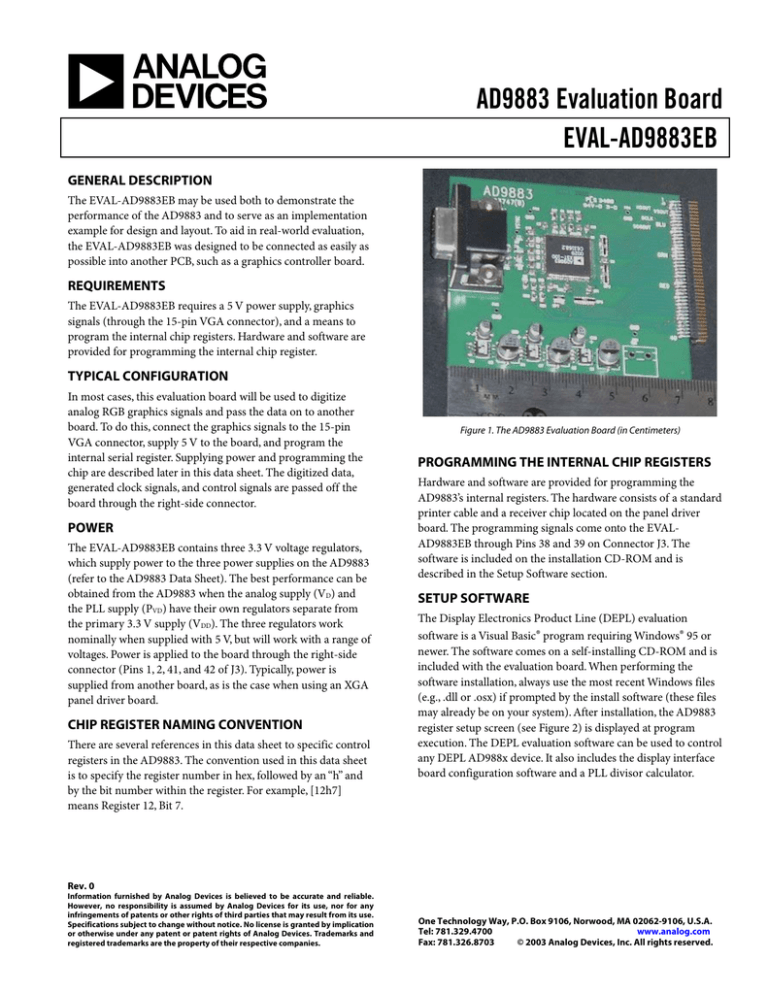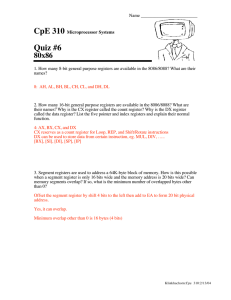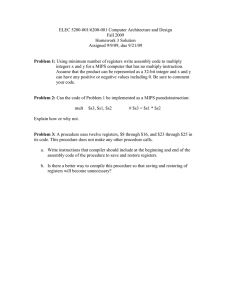
AD9883 Evaluation Board
EVAL-AD9883EB
GENERAL DESCRIPTION
The EVAL-AD9883EB may be used both to demonstrate the
performance of the AD9883 and to serve as an implementation
example for design and layout. To aid in real-world evaluation,
the EVAL-AD9883EB was designed to be connected as easily as
possible into another PCB, such as a graphics controller board.
REQUIREMENTS
The EVAL-AD9883EB requires a 5 V power supply, graphics
signals (through the 15-pin VGA connector), and a means to
program the internal chip registers. Hardware and software are
provided for programming the internal chip register.
TYPICAL CONFIGURATION
In most cases, this evaluation board will be used to digitize
analog RGB graphics signals and pass the data on to another
board. To do this, connect the graphics signals to the 15-pin
VGA connector, supply 5 V to the board, and program the
internal serial register. Supplying power and programming the
chip are described later in this data sheet. The digitized data,
generated clock signals, and control signals are passed off the
board through the right-side connector.
POWER
The EVAL-AD9883EB contains three 3.3 V voltage regulators,
which supply power to the three power supplies on the AD9883
(refer to the AD9883 Data Sheet). The best performance can be
obtained from the AD9883 when the analog supply (VD) and
the PLL supply (PVD) have their own regulators separate from
the primary 3.3 V supply (VDD). The three regulators work
nominally when supplied with 5 V, but will work with a range of
voltages. Power is applied to the board through the right-side
connector (Pins 1, 2, 41, and 42 of J3). Typically, power is
supplied from another board, as is the case when using an XGA
panel driver board.
CHIP REGISTER NAMING CONVENTION
There are several references in this data sheet to specific control
registers in the AD9883. The convention used in this data sheet
is to specify the register number in hex, followed by an “h” and
by the bit number within the register. For example, [12h7]
means Register 12, Bit 7.
Figure 1. The AD9883 Evaluation Board (in Centimeters)
PROGRAMMING THE INTERNAL CHIP REGISTERS
Hardware and software are provided for programming the
AD9883’s internal registers. The hardware consists of a standard
printer cable and a receiver chip located on the panel driver
board. The programming signals come onto the EVALAD9883EB through Pins 38 and 39 on Connector J3. The
software is included on the installation CD-ROM and is
described in the Setup Software section.
SETUP SOFTWARE
The Display Electronics Product Line (DEPL) evaluation
software is a Visual Basic® program requiring Windows® 95 or
newer. The software comes on a self-installing CD-ROM and is
included with the evaluation board. When performing the
software installation, always use the most recent Windows files
(e.g., .dll or .osx) if prompted by the install software (these files
may already be on your system). After installation, the AD9883
register setup screen (see Figure 2) is displayed at program
execution. The DEPL evaluation software can be used to control
any DEPL AD988x device. It also includes the display interface
board configuration software and a PLL divisor calculator.
Rev. 0
Information furnished by Analog Devices is believed to be accurate and reliable.
However, no responsibility is assumed by Analog Devices for its use, nor for any
infringements of patents or other rights of third parties that may result from its use.
Specifications subject to change without notice. No license is granted by implication
or otherwise under any patent or patent rights of Analog Devices. Trademarks and
registered trademarks are the property of their respective companies.
One Technology Way, P.O. Box 9106, Norwood, MA 02062-9106, U.S.A.
Tel: 781.329.4700
www.analog.com
Fax: 781.326.8703
© 2003 Analog Devices, Inc. All rights reserved.
EVAL-AD9883EB
Figure 2. AD9883 Register Setup Screen
AD9883 SOFTWARE CONTROL
PLL Settings
To select the AD9883 as the DEPL evaluation software’s target
device, select AD9883 from the Device pull-down menu. From
the AD9883 register setup screen (shown in Figure 2), the user
can control every bit within the AD9883. A detailed, bit-by-bit
functional description is provided in the AD9883 Data Sheet.
Unless the Load Register On Change box is checked, the user
must click the Load button at the top of the window in order to
update the AD9883’s registers. If Load Register On Change is
checked, the appropriate register is updated as soon as any
change is made in the window. The three tabs in this control
window enable the selection of groups of registers to be
displayed. The selections are 00–0F, 10–14, or 15. Click the
appropriate tab to view and/or control the desired register.
The PLL settings are contained in Registers 01 to 04. The PLL
Divisor setting (12 bits) can be set bit-by-bit (the value toggles
when clicking on the bit), by setting a value (in decimal) for
Registers 01h and 02h, by setting the 12-bit value (in decimal),
or by moving the control bar right or left to increase or decrease
the value. When changing the value using one of these methods,
the change is reflected in the other three. The values are not
written to the AD9883 until the Load button is clicked. The
VCO Range and Charge Pump settings in Register 03h can be
set bit-by-bit, by register, or by pull-down menu selection. The
5-bit Phase Adjust in Register 04h can be altered in the same
manner as the PLL Divisor.
Rev. 0 | Page 2 of 4
EVAL-AD9883EB
Clamp and Hsync Out Settings
SOG and Clamp Control
Clamp Placement, Clamp Duration, and Hsync Out Width
controls are contained in Registers 05h to 07h and can be
changed bit-by-bit, by setting a value for the registers (decimal
value), or by moving the control bar right or left to increase or
decrease the value. When changing the value using one of these
methods, the change is reflected in the other two. Again, unless
the Load Register On Change box is checked, these changes are
not loaded into the AD9883 until the Load button is clicked.
Register 10h contains bits for controlling the SOG Threshold
and Clamp selection functions. Register 11h contains bits for
adjusting the Sync Separator Threshold. The 5-bit (7:3) SOG
Threshold can be modified bit-by-bit or by changing the 5-bit
(decimal) value. Each of the Clamp Selection bits can be toggled
by clicking on it. The resulting state of the bit is reflected in the
box to the right of each bit. The Sync Separator Threshold can
be changed bit-by-bit, by setting a value for the register (decimal
value), or by moving the control bar right or left to increase or
decrease the value. Refer to the AD9883 Data Sheet for a
functional description of these bits.
Gain and Offset Settings
Gain for the Red, Green, and Blue video channels is controlled
via all eight bits of Registers 08h to 0Ah and can be changed bitby-bit, by setting a value for the registers (decimal value), or by
moving the control bar right or left to increase or decrease the
value. The 7-bit offset control for the red, green, and blue
channels is contained in Registers 0Bh to 0Dh. These seven bits
can be set in the same manner as gain, with the additional
option of setting the 7-bit decimal value. Note that using the
gain and offset control bars will change all three channels by the
same amount, regardless of their setting. For example, if, in
order to achieve color balance, the offset settings are 60, 70, and
80 for R, G, and B, respectively, then the minimum settings are
0, 10, and 20. The maximum offset settings would then be 107,
117, and 127.
Sync Control
Register 0Eh contains bits for controlling input and output
Hsync and Vsync signals. The user can toggle each bit by
clicking on it. The resulting state of the bit is reflected in the box
to the right of each bit. Refer to the AD9883 Data Sheet for a
functional description of these bits.
Clamp, Coast, and Power Management
Register 0Fh contains bits for controlling the Clamp, Coast, and
Power Management functions. The user can toggle each bit by
clicking on it. The resulting state of the bit is reflected in the box
to the right of each bit. Refer to the AD9883 Data Sheet for a
functional description of these bits.
Pre-Coast and Post-Coast
Registers 12h and 13h contain the bits for controlling Pre-Coast
and Post-Coast. The 8-bit Pre-Coast and 8-bit Post-Coast can
be modified bit-by-bit or by changing the 8-bit (decimal) value.
The resolution of this adjustment is in Hsync periods. These
adjustments apply to the AD9833’s internal Coast function and
do not alter an external Coast signal. Refer to the AD9883 Data
Sheet for a functional description of these bits.
Sync and Coast Status (Read-Only)
Register 14h is a read-only register that provides the status of
Hsync, Vsync, SOG, and Coast polarity. Performing a read (by
clicking the Read button at the bottom of the window) allows
the user to see the status of each of these bits; the status is also
reflected in the text to the right of these bits. Refer to the
AD9883 Data Sheet for a functional description of these bits.
SCHEMATICS AND LAYOUT
The schematics and layout for this board are included in
separate files, which can be found on the CD-ROM.
CONTACT INFORMATION
If you have questions or would like more information, email us
directly at flatpanel_apps@analog.com, visit our website at
http://www.analog.com/flatpanel, or call the Analog Devices
help line at 1-800-AnalogD (1-800-262-5643).
Rev. 0 | Page 3 of 4
EVAL-AD9883EB
Table 1. Sample Settings for the EVAL-AD9883EB
Mode
VGA
SVGA
XGA
SXGA
1
2
Resolution
640 × 480 @ 60 Hz
640 × 480 @ 72 Hz
640 × 480 @ 75 Hz
640 × 480 @ 85 Hz
800 × 600 @ 56 Hz
800 × 600 @ 60 Hz
800 × 600 @ 72 Hz
800 × 600 @ 75 Hz
800 × 600 @ 85 Hz
1024 × 768 @ 60 Hz
1024 × 768 @ 70 Hz
1024 × 768 @ 75 Hz
1024 × 768 @ 80 Hz
1024 × 768 @ 85 Hz
1280 × 1024 @ 60 Hz
1280 × 1024 @ 75 Hz
PLL Timing Chart
Horizontal Sync
Nominal Frequency
PLL Divider1
(kHz)
Polarity
(N + 1)
31.469
N
800
37.861
N
832
37.500
N
840
43.269
N
832
35.156
N/P
1024
37.879
P
1056
48.077
P
1040
46.875
P
1056
53.674
P
1048
48.363
N
1344
56.476
N
1328
60.023
P
1312
64.000
P
1336
68.677
P
1376
60.020
P
1688
80.000
P
1688
Nominal Pixel
Clock (MHz)
25.175
31.500
31.500
36.000
36.000
40.000
50.000
49.500
56.250
65.000
75.000
78.750
85.500
94.50
108.000
135.000
The PLL divisor to the chip should be an odd integer. Chip divide ratio = Input N + Offset of 1.
The VCO range and charge pump current settings are preliminary and may need slight adjustments.
ESD CAUTION
ESD (electrostatic discharge) sensitive device. Electrostatic charges as high as 4000 V readily accumulate on the
human body and test equipment and can discharge without detection. Although this product features
proprietary ESD protection circuitry, permanent damage may occur on devices subjected to high energy
electrostatic discharges. Therefore, proper ESD precautions are recommended to avoid performance
degradation or loss of functionality.
ORDERING GUIDE
Model
AD9883A/PCB
Package Description
Evaluation Board
© 2003 Analog Devices, Inc. All rights reserved. Trademarks and
registered trademarks are the property of their respective companies.
C04327–0–7/03(0)
Rev. 0 | Page 4 of 4
VCO
Range2
00
00
00
01
01
01
01
01
01
10
10
10
10
10
10
11
Charge Pump
Current2
110
110
110
100
100
100
101
101
101
101
100
100
101
101
100
110




